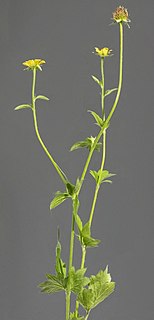
Geum urbanum, also known as wood avens, herb Bennet, colewort and St. Benedict's herb, is a perennial plant in the rose family (Rosaceae), which grows in shady places in the temperate regions of Eurasia. It has been introduced in North America, where it forms natural hybrids with Geum canadense.

Geum rivale, the water avens, is a flowering plant in the genus Geum within the family Rosaceae. Other names for the plant are nodding avens, drooping avens, cure-all, water flower and Indian chocolate. It is native to the temperate regions of Europe, Central Asia and parts of North America, where it is known as purple avens. It grows in bogs and damp meadows, and produces nodding red flowers from May to September.

Geum aleppicum, commonly called yellow avens or common avens is a flowering plant native to most of the temperate Northern Hemisphere, from eastern Europe across Asia and North America.
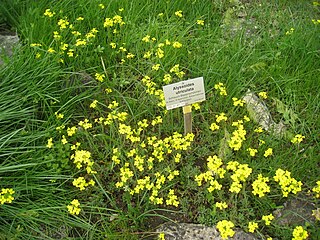
Alyssoides is a genus of flowering plants in the family Brassicaceae containing a single species, Alyssoides utriculata. A herbaceous perennial plant native to Southern Europe and Turkey, it grows on dry rocky slopes and on calcareous rocks, reaching heights of 20 to 50 cm and blooming with yellow flowers between April and May–July.

Geum bulgaricum is a species of flowering plant of the genus Geum (avens) in the family Rosaceae. A perennial herbaceous plant, it has small, bell-like yellow flowers, and is native to a few mountains on the Balkan Peninsula.
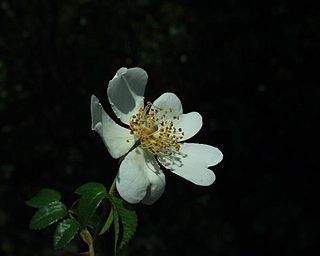
Rosa sempervirens, the evergreen rose, is a species of wild rose native to the Mediterranean. It is a climbing perennial with very prickly stems.

The flora of Italy was traditionally estimated to comprise about 5,500 vascular plant species. However, as of 2019, 7,672 species are recorded in the second edition of the flora of Italy and in its digital archives Digital flora of Italy. In particular, 7,031 are autochthonous and 641 are non native species widely naturalized since more than three decades. Additionally, further 468 exotic species have been recorded as adventitious or naturalized in more recent times. Geobotanically, the Italian flora is shared between the Circumboreal Region and Mediterranean Region. According to the index compiled by the Italian Ministry for the Environment in 2001, 274 vascular plant species were protected.
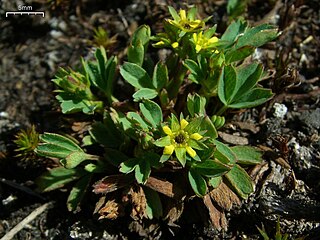
Sibbaldia procumbens is a species of flowering plant of the genus Sibbaldia in the rose family. It has an Arctic–alpine distribution; it can be found throughout the Arctic, as well as the at higher elevations in the mountains of Eurasia and North America. It grows on tundra and in alpine climates where snow remains year-round, and on subalpine mountain slopes. This is a low, mat-forming perennial herb producing clumps of herbage in rocky, gravelly substrate. A spreading stem up to 15 centimeters long grows from a caudex. Each leaf is divided into usually three leaflets borne at the end of a petiole up to 7 centimeters long. Each wedge-shaped leaflet has three teeth at the tip. The flower has usually five pointed green bractlets, five wider pointed green sepals, and five tiny yellowish petals each about a millimeter long. The fruits develop in the remnants of the sepals on erect stalks.

Geum coccineum is a species of flowering plant in the genus Geum, in the rose family Rosaceae. Native to the mountains of the Balkans and northern Turkey, it is also grown ornamentally for its bright red flowers.

Geum montanum, the Alpine avens, is a species of flowering plant of the genus Geum in the Rosaceae family, native to the mountains of central and southern Europe.
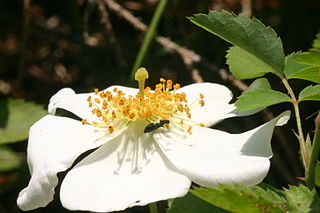
Rosa arvensis, the field rose, is a species of wild rose native to Western, Central and Southern Europe.

Rosa pendulina,, the Alpine rose or mountain rose, is a species of wild rose found in the mountains of central and southern Europe. It appears to have survived in glacial refugia in the Alps and Carpathians, and spread out from there. A climbing shrub with deep pink flowers and relatively few thorns, it has had a history of cultivation as an ornamental plant.

Rosa tomentosa, otherwise known as the harsh downy-rose, is a species of wild rose. It is a shrub growing to about 3 metres (10 ft). It is found in Asia Minor, the Caucasus, and much of Europe: the British Isles, France, Central Europe, northern Spain, Italy, and the Balkans . On the British Isles it can be found in hedgerows and woodland margins, and it typically flowers between June and July. Further south, in Bulgaria, it flowers in May.
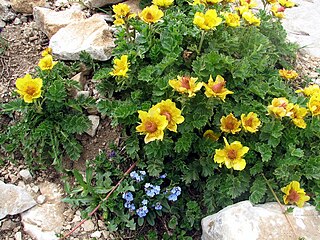
Geum reptans, the creeping avens, is a species of flowering plant in the genus Geum of the family Rosaceae native to some mountains of Central and Southeastern Europe. A long-lived perennial that reproduces both sexually and clonally, it has high phenotypic variation, but these variable traits do not appear to be adaptations to local conditions.
Rosa oxyodon is a species of wild rose native to the Caucasus. It is closely related to Rosa pendulina.
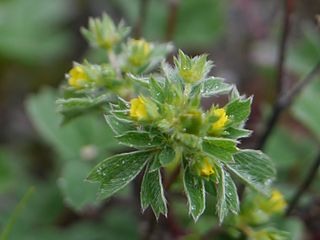
Sibbaldia parviflora is a species of flowering plant in the genus Sibbaldia of the family Rosaceae, native to Southeast Europe and West Asia. It is a herbaceous perennial plant growing in damp rocky places on alpine meadows.
Geum borisii may refer to the following plants of the genus Geum:
Alyssum minutum is a species of flowering plant in the genus Alyssum, family Brassicaceae, native to the Mediterranean and Eastern Europe.
Alyssum pulvinare is a species of flowering plant in the genus Alyssum (madwort) of the family Brassicaceae. A perennial herbaceous plant native to the Balkans, it grows on rocky places, rock ledges and dry grassy slopes, forming tufts about 6–15 cm high. It flowers in May and June.














